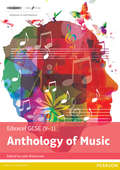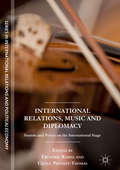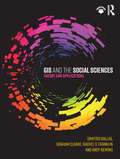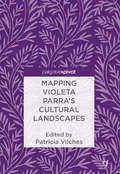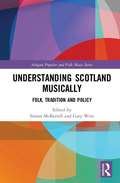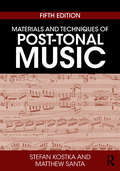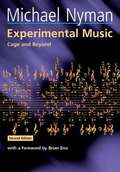- Table View
- List View
Symphony No 104: second movement (three part arrangement) (PDF)
by Saz HaydnThis is a musical score in Modified Stave Notation. The original file is available as .mscz format and the braille music version as .brf from mas@rnib.org.uk
Symphony No 104: First movement, three part arrangement (PDF)
by Saz HaydnThis is a musical score in Modified Stave Notation. The original file is available as .mscz format and the braille music version as .brf from mas@rnib.org.uk
Symphony No. 4 (Italian): First movement (three part arrangement) (PDF)
by Mendelssohn SazThis is a musical score in Modified Stave Notation. The original file is available as .mscz format and the braille music version as .brf from mas@rnib.org.uk
Defying Gravity (PDF)
by SchwartzSet work score for Edexcel/Pearson GCSE Music from 2016. Part of a multi-media version. Braille music and audio available from mas@rnib.org.uk
Samba Em Preludio (PDF)
by Esperanza SpaldingSet work score for Edexcel/Pearson GCSE Music from 2016. Part of a multi-media version. Braille music and audio available from mas@rnib.org.uk
Since You've Been Gone (PDF)
by Rainbow SazThis is a musical score in Modified Stave Notation. The original file is available as .mscz format and the braille music version as .brf from mas@rnib.org.uk
Since You've Been Gone (PDF)
by Rainbow SazThis is a musical score in Modified Stave Notation. The original file is available as .mscz format and the braille music version as .brf from mas@rnib.org.uk
Eine Kleine Nachtmusik K525 third movement (PDF)
by Mozart SazThis is a musical score in Modified Stave Notation. The original file is available as .mscz format and the braille music version as .brf from mas@rnib.org.uk
Release - instrumental loops (PDF)
by Afro Celt Sound SystemThis is a musical score in Modified Stave Notation. The original file is available as .mscz format and the braille music version as .brf from mas@rnib.org.uk
Release - vocal loops (PDF)
by Afro Celt Sound SystemThis is a musical score in Modified Stave Notation. The original file is available as .mscz format and the braille music version as .brf from mas@rnib.org.uk
"Killer Queen" from "Sheer Heart Attack" (PDF)
by Freddie Mercury Saz Ed.This is a musical score in Modified Stave Notation. The original file is available as .mscz format and the braille music version as .brf from mas@rnib.org.uk
Main Title/Rebel Blockade Runner from"Star Wars: EpisodeIV A New Hope" (PDF)
by John Williams SazThis is a musical score in Modified Stave Notation. The original file is available as .mscz format and the braille music version as .brf from mas@rnib.org.uk
Music for a While (PDF)
by H. Purcell SazThis is a musical score in Modified Stave Notation. The original file is available as .mscz format and the braille music version as .brf from mas@rnib.org.uk
Brandenburg Concerto no 5 Third Movement, three part arrangement (PDF)
by J. S. Bach SazThis is a musical score in Modified Stave Notation. The original file is available as .mscz format and the braille music version as .brf from mas@rnib.org.uk
Piano Sonata no. 8 "Pathetique" First movement, skeleton score (PDF)
by BeethovenThis is a musical score in Modified Stave Notation. The original file is available as .mscz format and the braille music version as .brf from mas@rnib.org.uk
International Relations, Music and Diplomacy: Sounds and Voices on the International Stage (The Sciences Po Series in International Relations and Political Economy)
by Frédéric Ramel Cécile Prévost-ThomasThis volume explores the interrelation of international relations, music, and diplomacy from a multidisciplinary perspective. Throughout history, diplomats have gathered for musical events, and musicians have served as national representatives. Whatever political unit is under consideration (city-states, empires, nation-states), music has proven to be a component of diplomacy, its ceremonies, and its strategies. Following the recent acoustic turn in IR theory, the authors explore the notion of “musical diplomacies” and ask whether and how it differs from other types of cultural diplomacy. Accordingly, sounds and voices are dealt with in acoustic terms but are not restricted to music per se, also taking into consideration the voices (speech) of musicians in the international arena.Read an interview with the editors here: https://www.sciencespo.fr/ceri/en/content/international-relations-music-and-diplomacy-sounds-and-voices-international-stage
International Relations, Music and Diplomacy: Sounds and Voices on the International Stage (The Sciences Po Series in International Relations and Political Economy)
by Frédéric Ramel Cécile Prévost-ThomasThis volume explores the interrelation of international relations, music, and diplomacy from a multidisciplinary perspective. Throughout history, diplomats have gathered for musical events, and musicians have served as national representatives. Whatever political unit is under consideration (city-states, empires, nation-states), music has proven to be a component of diplomacy, its ceremonies, and its strategies. Following the recent acoustic turn in IR theory, the authors explore the notion of “musical diplomacies” and ask whether and how it differs from other types of cultural diplomacy. Accordingly, sounds and voices are dealt with in acoustic terms but are not restricted to music per se, also taking into consideration the voices (speech) of musicians in the international arena.Read an interview with the editors here: https://www.sciencespo.fr/ceri/en/content/international-relations-music-and-diplomacy-sounds-and-voices-international-stage
Acoustic And Midi Orchestration For The Contemporary Composer: A Practical Guide To Writing And Sequencing For The Studio Orchestra (PDF)
by Andrea Pejrolo Rich DeRosaAcoustic and MIDI Orchestration for the Contemporary Composer, Second Edition provides effective explanations and illustrations to teach you how to integrate traditional approaches to orchestration with the use of the modern sequencing techniques and tools available to today’s composer. By covering both approaches, Pejrolo and DeRosa offer a comprehensive and multifaceted learning experience that will develop your orchestration and sequencing skills and enhance your final productions. A leading manual on its subject, the second edition allows experienced composers and producers to be exposed to sequencing techniques applied to traditional writing and arranging styles. The book continues to provide a comprehensive and solid learning experience and has been fully revised to include the latest tools and techniques. The new edition has been updated to include: A new chapter on cover writing and sequencing for vocal ensembles Coverage of writing for different ensemble sizes A new final chapter on writing and production techniques for mixed contemporary ensembles. All new techniques, tools, and sound libraries available to today’s composer. A companion website (www.routledge.com/cw/pejrolo) includes a wide selection of audio examples, templates, sounds, and videos showcasing operational processes, allows you the opportunity to listen to the techniques discussed within the book.
Mapping Violeta Parra’s Cultural Landscapes
by Patricia VilchesOne of the leading figures in Latin American folk music and art during her lifetime, Violeta Parra was a vital force in the artistic, musical, visual, cultural, and social cultural production of the Chilean 1960s. Fifty years after her death, she continues to deeply influence artists of the present day. This book revisits Parra’s work and legacy to illustrate her global impact across artistic and political boundaries. Contributors offer multi-disciplinary perspectives that delineate how Parra contributed to shaping and—at the same time—antagonizing, societal processes in mid-20th century Chile.
Mapping Violeta Parra’s Cultural Landscapes
by Patricia VilchesOne of the leading figures in Latin American folk music and art during her lifetime, Violeta Parra was a vital force in the artistic, musical, visual, cultural, and social cultural production of the Chilean 1960s. Fifty years after her death, she continues to deeply influence artists of the present day. This book revisits Parra’s work and legacy to illustrate her global impact across artistic and political boundaries. Contributors offer multi-disciplinary perspectives that delineate how Parra contributed to shaping and—at the same time—antagonizing, societal processes in mid-20th century Chile.
Acoustic And Midi Orchestration For The Contemporary Composer: A Practical Guide To Writing And Sequencing For The Studio Orchestra
by Andrea Pejrolo Rich DeRosaAcoustic and MIDI Orchestration for the Contemporary Composer, Second Edition provides effective explanations and illustrations to teach you how to integrate traditional approaches to orchestration with the use of the modern sequencing techniques and tools available to today’s composer. By covering both approaches, Pejrolo and DeRosa offer a comprehensive and multifaceted learning experience that will develop your orchestration and sequencing skills and enhance your final productions. A leading manual on its subject, the second edition allows experienced composers and producers to be exposed to sequencing techniques applied to traditional writing and arranging styles. The book continues to provide a comprehensive and solid learning experience and has been fully revised to include the latest tools and techniques. The new edition has been updated to include: A new chapter on cover writing and sequencing for vocal ensembles Coverage of writing for different ensemble sizes A new final chapter on writing and production techniques for mixed contemporary ensembles. All new techniques, tools, and sound libraries available to today’s composer. A companion website (www.routledge.com/cw/pejrolo) includes a wide selection of audio examples, templates, sounds, and videos showcasing operational processes, allows you the opportunity to listen to the techniques discussed within the book.
Understanding Scotland Musically
by Simon McKerrell Gary WestScottish traditional music has been through a successful revival in the mid-twentieth century and has now entered a professionalised and public space. Devolution in the UK and the surge of political debate surrounding the independence referendum in Scotland in 2014 led to a greater scrutiny of regional and national identities within the UK, set within the wider context of cultural globalisation. This volume brings together a range of authors that sets out to explore the increasingly plural and complex notions of Scotland, as performed in and through traditional music. Traditional music has played an increasingly prominent role in the public life of Scotland, mirrored in other Anglo-American traditions. This collection principally explores this movement from historically text-bound musical authenticity towards more transient sonic identities that are blurring established musical genres and the meaning of what constitutes ‘traditional’ music today. The volume therefore provides a cohesive set of perspectives on how traditional music performs Scottishness at this crucial moment in the public life of an increasingly (dis)United Kingdom.
Understanding Scotland Musically (PDF)
by Simon McKerrell Gary WestScottish traditional music has been through a successful revival in the mid-twentieth century and has now entered a professionalised and public space. Devolution in the UK and the surge of political debate surrounding the independence referendum in Scotland in 2014 led to a greater scrutiny of regional and national identities within the UK, set within the wider context of cultural globalisation. This volume brings together a range of authors that sets out to explore the increasingly plural and complex notions of Scotland, as performed in and through traditional music. Traditional music has played an increasingly prominent role in the public life of Scotland, mirrored in other Anglo-American traditions. This collection principally explores this movement from historically text-bound musical authenticity towards more transient sonic identities that are blurring established musical genres and the meaning of what constitutes ‘traditional’ music today. The volume therefore provides a cohesive set of perspectives on how traditional music performs Scottishness at this crucial moment in the public life of an increasingly (dis)United Kingdom.
Materials and Techniques of Post-Tonal Music
by Stefan Kostka Matthew SantaMaterials and Techniques of Post-Tonal Music, Fifth Edition provides the most comprehensive introduction to post-tonal music and its analysis available. Covering music from the end of the nineteenth century through the beginning of the twenty-first, it offers students a clear guide to understanding the diverse and innovative compositional strategies that emerged in the post-tonal era, from Impressionism to computer music. This updated fifth edition features: chapters revised throughout to include new examples from recent music and insights from the latest scholarship; the introduction of several new concepts and topics, including parsimonius voice-leading, scalar transformations, the New Complexity, and set theory in less chromatic contexts; expanded discussions of spectralism and electronic music; timelines in each chapter, grounding the music discussed in its chronological context; a companion website that provides students with links to recordings of musical examples discussed in the text and provides instructors with an instructor’s manual that covers all of the exercises in each chapter. Offering accessible explanations of complex concepts, Materials and Techniques of Post-Tonal Music, Fifth Edition is an essential text for all students of post-tonal music theory.
Experimental Music: Cage and Beyond (PDF)
by Michael Nyman Foreword by Brian EnoMichael Nyman's book is a first-hand account of experimental music from 1950 to 1970. First published in 1974, it has remained the classic text on a significant form of music making and composing which developed alongside, and partly in opposition to, the post-war modernist tradition of composers such as Boulez, Berio, or Stockhausen. The experimentalist par excellence was John Cage whose legendary 4' 33'' consists of four minutes and thirty three seconds of silence to be performed on any instrument. Such pieces have a conceptual rather than purely musical starting point and radically challenge conventional notions of the musical work. Nyman's book traces the revolutionary attitudes that were developed towards concepts of time, space, sound, and composer/performer responsibility. It was within the experimental tradition that the seeds of musical minimalism were sown and the book contains reference to the early works of Reich, Riley, Young, and Glass.

